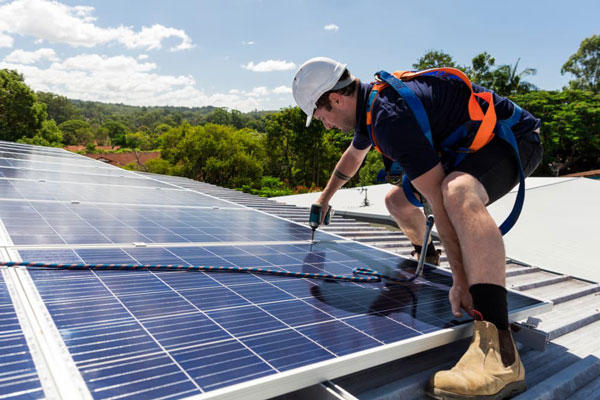
With the rapid growth and demand for Solar Energy solutions, the hazards and ordeals while installation and maintenance have become a concern regarding fall protection for solar installers. Fall from sites higher than six feet is one of the leading causes of death; hence, OSHA requirements for solar installers to ensure the safety of the roof workers.
The fall protection guidelines are listed to ensure the safety and efficiency of workers to provide a thorough guideline for hassle-free conduct.

The workers must take time to assess the roof first before executing any safety methods suitable for the working site.
The roof has to be dry and clean before commencing the work. Locate any skylight, plastic roof sheeting, asbestos cement setting, or other brittle roof material, and plan your work to avoid walking or sorting the material near them.
Determine the best fall protection system to use and ensure all the process step by step to steer clear of any mishap. Prevention techniques have to be put to use to ignore these accidents.
Falls can be prevented through harness-based systems, restraining techniques, and fall arrest systems to prevent workers from falling and injuring themselves.
Guardrail systems, safety net systems, and several personal fall arrest systems are advised to the installation personnel while undertaking a project on rooftops or elevated surfaces.
While using ladders, workers should be secured at the top and bottom, and extend at least 1 meter above the roof edge.
Where the work is positioned, the worker is suspended by a rope or harness to move freely while working without risking a fall leading to injury. The rope is under pressure at all times so there’s no slack in the system.
Check if the surface is dry and clean and if all the equipment is fit for purpose.
Use barricades or similar controls to prevent people from entering the working site during the process.

The restraint technique involves a type of fall arrest system where the worker constantly adjusts the lanyard length to prevent them from reaching a position where there’s the risk from fall. It also provides a large area but must be used carefully to avoid excessive slack.
The restraint technique stops the workers from reaching the edge of the roof, however, it doesn’t eliminate the chance to get injured from a brittle work surface.
The two types of fall protection methods are –
Other types of fall arrest systems may include non-adjustable systems, lifelines, catch platforms, and safety nets.
All items on the roof must be secured to prevent falls. Store materials where they can be adequately supported and ensure that they are not blown away.
The California Fatality Assessment and Control Evaluation (CA/FACE) program track and investigate cases of fatal injuries occurring while installing solar panels, and recommends safety regulations.
Every year, unfortunate accidents occur due to working on pitched roofs, close to the roof’s edge, lack of fall protection for solar installers’ equipment/ methods, the proximity of overhead power lines, and unguarded skylights.

Occupational safety and health administration (OSHA) has different fall protection requirements for construction and general maintenance.
Construction workers involved in the installation of solar panels are exposed to fall distances of 6 feet or more and must be protected by following these safety measures and approved procedures.
The system involves a non-penetrating railing for the rooftops and provides protection from falls off the edge of the roof. The use of guardrails also protects workers on elevated surfaces, around skylights, or other rooftop machinery.
If you choose to use a guardrail system, the following provisions must be complied with:
Oftentimes the nature and location of the work will determine ways for ensuring safety. If you choose to use a safety net system, you must comply with the following provisions:
A personal fall arrest system is another option of protection that OSHA requires for workers and individual undertakers who are exposed to vertical drops from 6 feet or higher.
A personal fall arrest system requires the following tools and instruments to ensure the complete safety of the installers on Solar Panels.
They are required to have a safe attachment location, body harness, vertical lifeline/ lanyard, webbing, anchorage, horizontal lifeline, connectors, and a self-arrest system.
Solar panels should be lifted safely to the rooftops. Workers should never be allowed to climb ladders while carrying solar panels. Lifting equipment, such as ladder hoists, swing hoists, or truck-mounted cranes/conveyors should be used wherever possible.
Use double-insulated tools and ground all exposed metal parts of equipment.
According to CA Public Health, every year around 16 workers die at work in the United States. Many of these workplace tragedies can be prevented with awareness and precaution. Before initiating work, the workers must be trained, fit for work, and demonstrate safe behavior and work practices. All workers must be aware of emergency procedures on-site in case any incident takes place. Workers must be obliged to stop working when they are feeling unsafe in the working situation. Adequate supervision has to be ensured for fall protection for solar installers to administer the systems being exercised responsibly.
